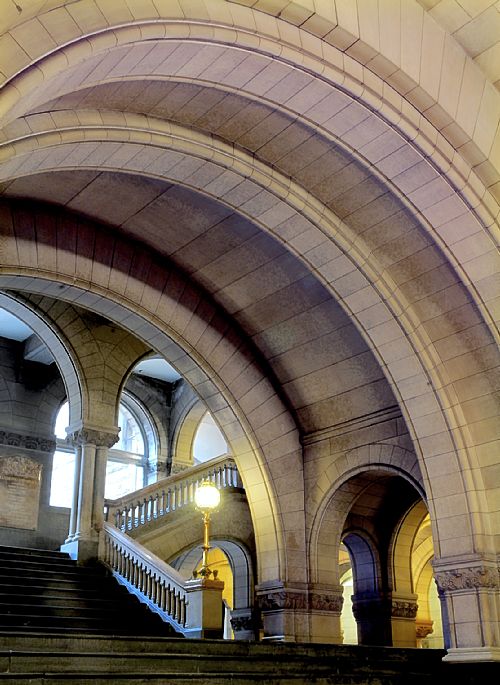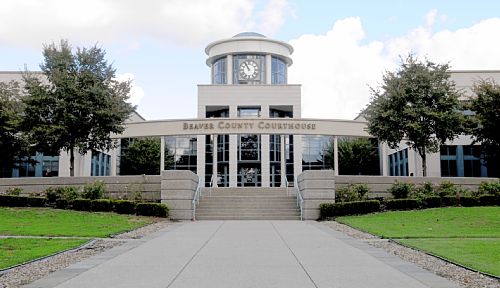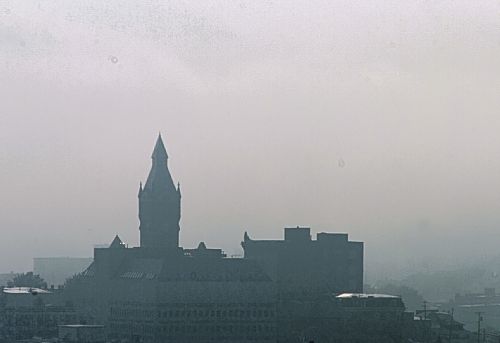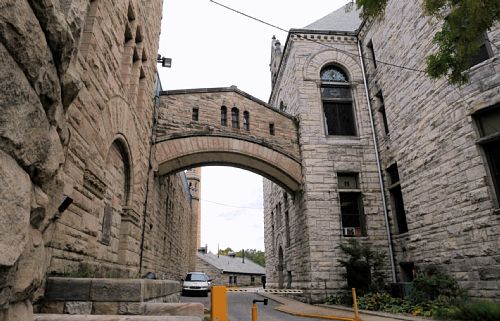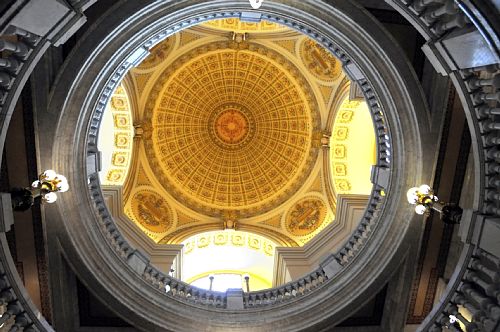
Category Archive: Pittsburgh Post-Gazette
-
Exhibit Celebrates the Many Styles of Homes in Beaver
Saturday, November 06, 2010By Marylynne Pitz, Pittsburgh Post-Gazette
A model replica of the Agnew-Anderson House, built in 1808, is among the exhibits in "Bricks, Mortar and Charm," an exhibition at the Beaver Area Heritage Museum. Bob Donaldson / Post-Gazette
BEAVER — Since 1802, this town 35 miles northwest of Pittsburgh has reflected the aspirations of the bankers, doctors, teachers, lawyers and politicians who inhabit its quaint streets and River Road, a lovely stretch of beautiful homes that overlooks the Ohio River.
Now, this community’s architectural aspirations are on view in a concise exhibition called “Two Hundred Years of Bricks, Mortar & Charm” at the Beaver Area Heritage Museum in downtown Beaver.
Local historians believe that a house built in 1805 and still standing at River Road and Market Street is the town’s oldest structure. Part of the home’s front section was built with hand-hewn logs that are still visible in the basement. The logs may have been salvaged from Fort McIntosh, a Revolutionary War structure built in 1778.
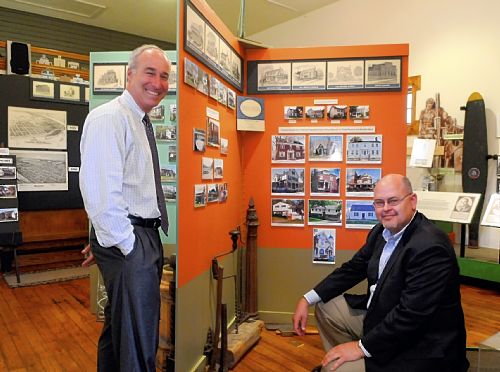
Edwards McLaughlin, left, and Mark Miner of the Beaver Area Heritage Museum take a look at "Bricks, Mortar and Charm," an exhibition that documents the architecture of Beaver. Bob Donaldson / Post-Gazette
Edwards McLaughlin, chairman of the museum’s board of trustees, spent weeks photographing homes all over Beaver for the exhibition, which examines the evolution of design styles in 50-year periods. His volunteer work correlates to his day job because he’s a partner in the real estate firm Bovard Anderson and a fourth-generation owner of the business.
With its 19th-century-style street lights and restored storefronts, Beaver retains its Victorian-era look. So it’s no surprise that from 1850 to 1900, plenty of Colonial Revival, Queen Anne and other Victorian-period homes were built. There’s also a smattering of Italianate, Gothic Revival and Romanesque homes.
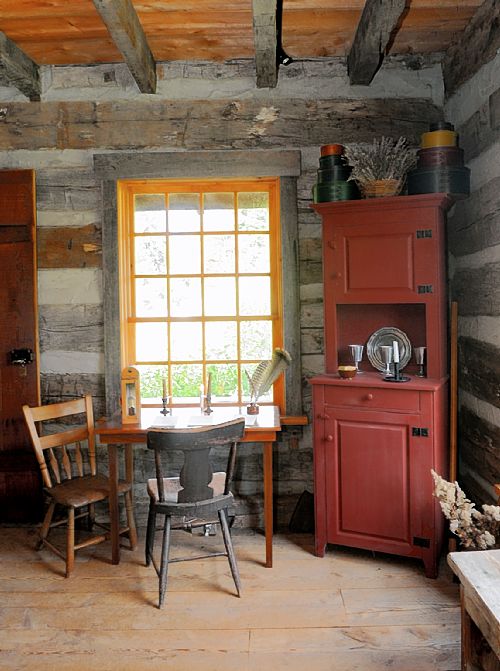
A replica log cabin is part of the Beaver Area Heritage Museum's permanent exhibit. Bob Donaldson / Post-Gazette
Surveyor Daniel Leet laid out Beaver, creating four squares in the center of town and four at its edge. Each one is named for a prominent resident or military leader. Agnew Square, for example, is named for Daniel Agnew, who was chief justice of the Pennsylvania Supreme Court. At Third Street and College Avenue, an exact replica of the clock tower that adorned the 1877 courthouse stands on the southeast corner.
A new century dawned and tastes changed between 1900 and 1950. As a result, Beaver has examples of English Tudor, Craftsman bungalows and Art Deco designs. There are even examples of Prairie-style homes, a Frank Lloyd Wright design ideal that emphasizes an open floor plan, horizontal lines, shallow roofs with broad overhangs and banks of casement windows with art glass.
The exhibition features an excellent model of Beaver’s 1877 courthouse plus a replica of the Agnew Anderson House. Both were made by Robert A. Smith.
Mr. McLaughlin is just one of several hundred volunteers who combined their collective, considerable elbow grease to transform a former Pennsylvania & Lake Erie Railroad freight house into the Beaver Area Heritage Museum 12 years ago. The building was a shambles with holes in the ceiling, thick grime on the floors and a basement packed with old dust.
Now, the museum sparkles. There’s a permanent exhibition about the Beaver region, an outdoor vegetable and herb garden with native plants and an 1802 log house that’s a replica of a frontier home.
Mildred “Midge” Sefton, a retired home economics teacher, oversees the volunteers, who meet regularly on Thursday mornings in the basement to accession, catalog and log onto a database each artifact and document that is donated to the museum. Judy Reiners of Beaver recently finished compiling family documents that belonged to Adolf Mulheim, proprietor of a wallpaper and carpet store from around 1880 to the 1930s.
-
Counties Seek Funds to Refurbish Mon River Ferry
Friday, November 05, 2010Pittsburgh Post-GazetteThe Washington County Commissioners have approved a $971,000 federal grant application to refurbish the Fredericktown Ferry, better known as Fred, which links two tiny towns separated by the Monongahela River.
Fayette County officials signed off on the application last year.
The Port of Pittsburgh Commission recommended repairing the cable driven ferry that shuttles vehicles and passengers across 800 feet of the river between Fredericktown, Washington County, and LaBelle in Fayette County.
The three- to four-minute trip saves motorists from driving about 16 miles to the nearest bridge.
The 60-foot-steel boat can carry six vehicles per trip, and transports about 500 each day.
-
Setback Won’t Deter Move of Historic House
Friday, November 05, 2010By Len Barcousky, Pittsburgh Post-GazettePaul Orange hasn’t given up hope that he will be able to buy and relocate the historic William Smith House in Mercersburg, despite a setback Thursday.
The house is on land owned by the MMP&W Volunteer Fire Co., which acquired the property in 2009 with plans to expand its aging facilities.
The board that oversees the regional fire company opened bids on Thursday for demolishing the 260-year-old structure but did not consider a proposal from Dr. Orange to move it.
Contacted after the meeting, Dr. Orange said he was advised that his offer to pay the fire company $100 for the building, rather than charge for tearing it down, had not been submitted in the right form.
The fire board, however, took no action on the demolition bids it received during its 15-minute meeting. That decision gives him hope that he still can reach an agreement to preserve the house, he said.
Joel Bradnick, a spokesman for the fire board, said the five bids would be forwarded to the fire company’s engineer for evaluation. He described Dr. Orange’s offer as a nonbinding “one-line memo.”
The low bid for demolition was $18,000.
“But why pay $18,000 to knock something down when you have someone willing to give them money to take it away,” Dr. Orange said.
The fire station and the Smith House are next to each other on Mercersburg’s Main Street.
If he is able to reach an agreement to move the house — either with the fire company or with the firm chosen to do the demolition — the next likely step would be to acquire a new location nearby. One possibility is a lot on the other side of Main Street, the site of a closed gas station.
Relocation and land acquisition could cost him as much as $100,000.
The Smith House was built in the 1750s. Constructed as a one-story cottage, it was greatly modified in the 19th and 20th centuries with the addition of a second story and porches.
News that the Smith House might be demolished attracted the interest of a museum in Northern Ireland. The Ulster American Folk Park has been developing plans to rescue the 18th-century first floor of the structure and move it to Europe. There it would become part of a collection of buildings with ties to Scotch-Irish immigration history. Several structures at the outdoor museum were moved from their original sites in southwestern Pennsylvania.
Worries about demolition also resulted in the formation of a small citizens group called the Committee to Save the William Smith House. Committee members have thrown their support behind Dr. Orange’s efforts to move the building.
“I hope we all can come together in a goodwill effort to restore this important piece of history,” said Karen Ramsburg, president of the Smith House committee. “This is America’s house, and I think it could become a real tourism magnet near the Interstate 81 corridor.”
Mercersburg is about 150 miles southeast of Pittsburgh. It is about 10 miles west of the Greencastle exit of I-81.
William Smith, an 18th-century businessman and local magistrate, was one of the leaders of what historians describe as the earliest organized opposition to British rule of its American colonies.
His home was a meeting place in 1765 for mostly Scotch-Irish settlers who organized themselves into armed bands. They formed a local militia after concluding that neither the Quaker-dominated colonial government in Philadelphia nor British officials in London were able to protect them from Indian raids.
William Smith’s brother-in-law, James Smith, was the leader of a group of settlers known as the “Black Boys,” who disguised themselves with paint and Indian clothes. Armed and angry, the Black Boys stopped pack trains traveling from Philadelphia to Fort Pitt that they believed were carrying weapons and ammunition that would end up in the hands of their Native American enemies.
After the British sent troops to nearby Fort Loudon to protect the traders and arrest the Black Boys, the soldiers twice found themselves besieged by the frontier militia.
The shots fired in 1765, 10 years before the Battles of Lexington and Concord, could be called the opening shots of the American Revolution, supporters of the Smith House say.
Dr. Orange describes himself as a history buff. A Westmoreland County native, he is a graduate of Greensburg Central Catholic High School and Saint Vincent College. He has a family medical practice on Route 30, east of Chambersburg.
-
Civic Arena Seats, Other Items Up for Sale or Bid
Thursday, November 04, 2010By Mark Belko, Pittsburgh Post-GazetteFans will have a chance to buy seats and other memorabilia from the Civic Arena over the next two months through on-line sales.
The city-Allegheny County Sports & Exhibition Authority approved an agreement this morning with the Penguins related to the sale of assets from the Igloo, which closed at the end of July.
Seats from the arena will go on sale to Penguin season ticket holders in the next few days, a sale that will run until Nov. 30. That will be followed by a sale to the general public on Dec. 1. A pair of seats will cost $495. Buyers can choose from red, blue, black and, of course, orange seats, but they will not be able to request individual seat numbers. About 5,000 seat pairs will be available for purchase.
The seat sale will be followed by an online auction Dec. 8 for other arena memorabilia, some of which will include Penguins logos or the signatures of players.
Bidding for the memorabilia will start about two weeks before Dec. 8. The highest bidder will be awarded the items. Those who have placed a bid will be notified if they have been outbid leading up to the closing Dec. 8.
“Although I don’t like this phrase, it’s very similar to eBay,” said Shawn Allen, chief operating officer for AssetNation, which is handling the sale.
The first online auction will be on Nov. 17 for arena furniture.
All of the seat transactions will take place on www.iglooseats.com
Bidding will be conducted at www.asset-auctions.com
Those who don’t have access to the Internet can call 1-800-303-6511 for a paper bid form.
The sale is expected to generate $1.6 million for the SEA and $800,000 for the Penguins, who will donate their share to their foundation.
The SEA’s share ultimately could be used to help pay for the demolition of the iconic 49-year-old domed building to make way for redevelopment.
-
Courthouses Tower as Testaments to Our Pursuit of Justice, Desire to Document Memorable Moments
Thursday, November 04, 2010
By Janice Crompton, Pittsburgh Post-Gazette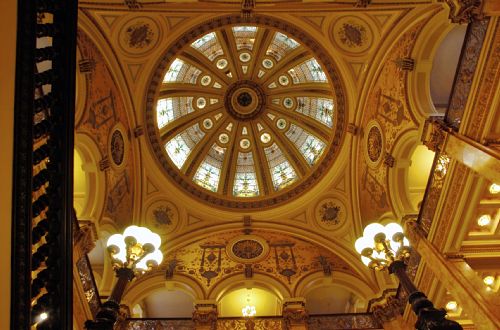
The dome inside the Washington County Courthouse, a building designed by Frederick J. Osterling. Bill Wade/Post-Gazette
The historic county courthouses of Western Pennsylvania are clearly more than mere buildings: Their walls bear witness to everything from birth to death.
They are, as Fayette County eloquently describes in a brochure, “… the scene of human drama, the repository of success and failure in life, the archive of the hopes and dreams of thousands.”
More than half of the courthouses of the 3,069 counties across the United States are recognized on the National Register of Historic Places, including five local ones: Allegheny, Butler, Fayette, Washington and Westmoreland.
This week, some of the courthouses, including those in Westmoreland and Beaver counties, took on a starring role as the official counting houses for Tuesday’s General Election.
Today, the majority of local county courthouses house the Common Pleas Court system and sometimes row offices, such as prothonotary, register of wills and clerk of courts. An exception is Allegheny County, which fused most row offices when voters approved a consolidation in 2005. The merger of the prothonotary, clerk of courts and register of wills offices formed the Department of Court Records, which is in the nearby City-County Building. But for the most part, the life-affirming and life-changing moments for each of us — births, marriages, home purchases and deaths — are recorded in a courthouse. And in the courthouse courtrooms, the drama of justice unfolds daily.
In addition, these buildings often honor and exhibit local history, such as the statue of the late Mayor Richard Caliguiri in Allegheny and the war memorials at the Washington and Beaver courthouses.
None of our local courthouses is an original. The first courthouses usually were primitive log cabins that gave way — often more than once — to grandiose architectural gems that have been rebuilt and reincarnated over the past two-plus centuries.
In his 2001 book, “County Courthouses of Pennsylvania,” Oliver P. Williams, a retired University of Pennsylvania political science professor, highlights each of Pennsylvania’s 67 courthouses. He visited each several times while doing his research.
In addition to providing details of architectural design, Dr. Williams examines the political climate and competitive atmosphere that led to the construction of some of the country’s finest monuments.
“I was always surprised how lavish public buildings were in the 19th century and how parsimonious they are now,” the 85-year-old said last week in a phone call from his home in Philadelphia. “There were plenty of tightwads in the 19th century, but the majority went the other way. Cities were in competition for growth and money.”
Before the interstate highway system was built, Dr. Williams traveled from Chicago to New York as a graduate student and he remembers seeing the tall spires of courthouses, beckoning travelers to visit their towns.
During the late 19th and early 20th centuries, courthouses typically were in the town square and the focus of local activity, he said. Trials there provided relief of boredom for spectators.
“Courtrooms were built like theaters,” Dr. Williams said. “They were big entertainment then.”
Several years ago, the Pennsylvania Supreme Court commissioned paintings of the state’s 67 county courthouses. Prints from those paintings are on display at the Pennsylvania Judicial Center, which opened in the summer of 2009 in Harrisburg.
Here’s a look at a half-dozen in our region:
Allegheny CountyThe Allegheny County Courthouse is “one of the most significant county courthouses in the United States from an architectural perspective,” Dr. Williams said.
Calling it “poetry in stone,” Dr. Williams wrote in his book that its beauty is an ideal example of Richardsonian Romanesque, an architectural style named for Henry Hobson Richardson, who believed, as his peers did, that the Allegheny County Courthouse was one of his crowning achievements.
“Richardson’s style was influential,” Dr. Williams said. “That courthouse was copied all over the nation.”
Mr. Richardson, also known for designing the Trinity Church in Boston, wanted to survive long enough to see the Allegheny County Courthouse completed, saying it was one of the works he wished to be judged by. He died, however, two years before it was finished in 1888.
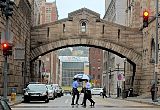
The "bridge" looms over Ross Street and connects to Court of Common Pleas building, formerly to old Allegheny County Prison, to the Allegheny County Courthouse in Downtown Pittsburgh. It is still used to transport suspects to the "Bull Pen" to wait for their trials and hearings. Darrell Sapp/Post-Gazette
Primarily built from “Milford pinkish gray granite,” according to Dr. Williams’ book, the structure was designed with as many windows as possible, to provide natural lighting. The building’s 318-foot tower not only was symbolic but also served as a ventilation system, pulling in fresh air from above rather than the polluted air near street level.
The building also features four Norman towers with conical roofs along with moldings and ornamental stonework that were hand carved by 13 Americans and 13 Italians, according to literature provided by the Pittsburgh History & Landmarks Foundation, which provides guided tours of the site.
“The thing that’s so extraordinary is the plan of the building,” said Albert Tannler, historical collections director for the foundation and author of a courthouse tour book. “It really is an amazing building.”
Possibly more impressive than the courthouse itself is the stone walkway, known as the “Bridge of Sighs,” that connects the courthouse to the jail, built at the same time and also designed by Mr. Richardson.
Patterned after the iconic bridge of the same name in Venice, the local bridge for decades provided a practical way to transport prisoners to and from the courthouse with minimal public contact.
Closed in 1995, the jail now serves as a family court center.
Beaver CountyLocated in Agnew Park in Beaver, the Beaver County Courthouse represents what Mr. Williams called “an architectural puzzle of a building.”
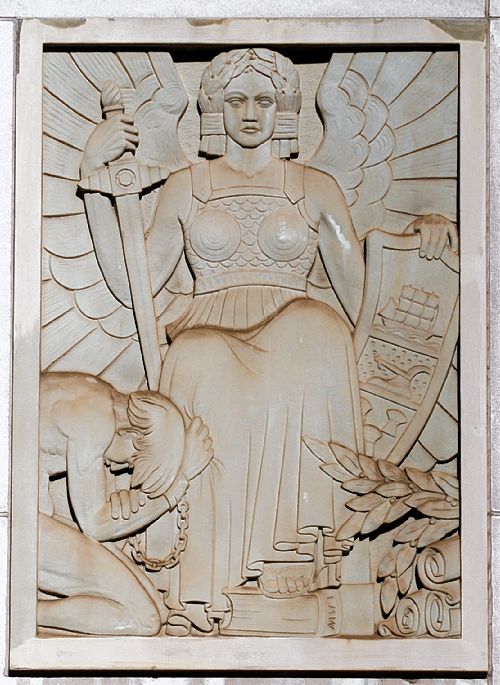
Concrete reliefs from the original Beaver County Courthouse now adorn the walls of the courtyard in the new courthouse, dedicated in January, 2003. Pam Panchak/Post-Gazette
Although it appears to be art moderne style, it contains unusual elements, such as a clock tower and a lunette, or crescent, window.
The eclectic mix is a result of a 1932 fire, which severely damaged the structure. Architects were able to salvage part of the burned 1875 courthouse, and they covered the new and old construction with a stone veneer, parts of which have been replaced over the years.
Butler CountyBuilt in 1885, the Butler County Courthouse has undergone several major alterations. Perhaps the most noticeable is the pointed stainless steel cap placed on its tower.
In his book, Mr. Williams explains how the shiny tower cap, which he calls “as durable as it is deforming,” was installed in 1958 after county commissioners found themselves unable to reject an offer of a free tower cap from Armco Steel.
The courthouse in Butler features a central clock tower with an elaborate cornice, a row of rosettes and arcaded corbels, or brackets, flanked by corner turrets, Mr. Williams said.
Gothic-arched windows on the first and second stories still have their stained-glass transoms.
Fayette CountyThe Fayette County courthouse is similar to the Richardsonian Romanesque style of the Allegheny County Courthouse, except it is smaller.
The gray sandstone courthouse in Uniontown features a 188-foot-tall central square tower, arcade windows and arched entryways. It also includes a “Bridge of Sighs” identical to the one in Allegheny County.
“Back in the day, that was the biggest compliment you could give an architect,” said Tammy Boyle, county human resources administrative assistant. “Today, you’d probably be sued.”
The design may have been borrowed from its neighbor to the north, but the structure is all Fayette County.
The stone was quarried locally, oak planks and panels were grown locally, and the iron for the building was rolled at a local mill. Even the brick used in the interior and for partition walls was made in the county.
The building has marble floors and iron stair railings, and the second-floor lobby contains four oval medallions, each 10 feet across, representing the county’s four leading industries at the time: coal mining, coke burning, agriculture and manufacturing.
While Ms. Boyle said the building is an architectural gem, it’s not without its drawbacks, especially when it comes to modern conveniences.
It’s no easy task to retrofit a historic building with wiring and security systems, not to mention plumbing and heating systems.
“There’s those days that we like it, and there’s those days when we don’t,” she said, speaking for county employees. “Sometimes in the winter it seems like we’re in Hades.”
Washington CountyWhen Debbie O’Dell Seneca was 13, she told her mother that she wanted to be a judge. She hadn’t yet laid eyes on the imposing sandstone and granite beaux-arts structure that is the Washington County Courthouse, but she never forgot the day she did.
“I was in complete awe,” she recalled. “It was like walking into a Roman cathedral.”
Today, she is Washington County president judge and she and others consider it an honor to work in the building, perched atop a large hill in Washington. It was built in 1900 and is crowned by a terra-cotta dome and statue of George Washington, both of which were recently refurbished.
Two 25-foot-high Italian Renaissance angels flanking the statue were removed when they began to deteriorate, but history buffs, including Judge O’Dell Seneca and county Commissioner J. Bracken Burns, have been pushing to have the angels restored.
Massive pilasters, Roman arches, Italian marble, bronze and highly polished brass grace the interior of the courthouse, which has a grand central stairway topped by a skylight.
Judge O’Dell Seneca said Architectural Digest in 1976 called it “one of the finest pieces of architecture in the United States.”
Westmoreland CountyAnother imposing and well-known beaux-arts style courthouse is in Greensburg.
Topped by a massive yellow-gold dome made of cast aluminum bronze over a rolled iron frame, the exterior is gray granite and “copiously decorated with the ornamental patterns learned at the Ecole des Beaux Arts,” Dr. Williams said.
The celebrated “Golden Dome,” as locals call it, is 175 feet above the sidewalk and arguably the signature piece on the county skyline.
Three arches grace the building’s entrance, framed by Corinthian pilasters, rosettes and bronze lamps. A marble staircase opens upward to twin spirals on the next floor. The structure contains marble walls in public halls, wall and ceiling murals, and a central rotunda that rises four stories to the domed ceiling.
The top of the building is graced by three female figures representing Justice, Guardian of the Law and Keeper of the Law — a fitting symbol for the courthouses themselves.
-
Physician Offers to Move Historic House in Mercersburg
Tuesday, November 02, 2010By Len Barcousky, Pittsburgh Post-Gazette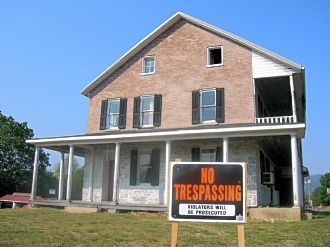
The Smith House is located next to the MMP&W Volunteer Fire Co. The board that oversees the fire company says it needs the land to expand its aging facilities. Len Barcousky/Post-Gazette
A Franklin County doctor has offered to relocate the historic Justice William Smith House in Mercersburg.
“I have a love of history,” Paul Orange said Monday.
He was reluctant to provide too many details of his proposal, but he said he was prepared to cover the costs of moving the two-story structure to a new location. Those expenses, including the cost of acquiring a suitable alternate property, could run as high as $100,000.
Dr. Orange has a family practice along Route 30 in Fayetteville, which is between Chambersburg and Gettysburg. He said he moved to the area in part because of its ties to important events during the Civil War. He is a graduate of Greensburg Central Catholic High School and St. Vincent College. After graduating from medical school at the American University of the Caribbean, he did his residency at Latrobe Hospital.
The Smith House is located next to the MMP&W Volunteer Fire Co. on Mercersburg’s Main Street. The board that oversees the fire company says it needs the land on which the house sits to expand its aging facilities, and it has sought bids for demolition of the building. Its initials stand for Mercersburg, Montgomery, Peters and Warren, which are the communities it serves.
The bids are to be opened Thursday, but the fire company has not said when it will award the contract.
Dr. Orange said he has submitted an offer to move the structure, which would save the fire company the expense of tearing it down.
His proposal has gained the support of a small citizens group, the Committee to Save the William Smith House, which has sought to head off any demolition plans.
“This is an amazing turn just when I thought we were dead in the water,” said Karen Ramsburg, who heads the Smith House committee. “I’m surprised and excited.”
One potential new home for the 18th-century building is the nearby site of a former gas station owned by the First National Bank of Mercersburg.
“The best-case scenario would be to keep the house in its current location,” Ms. Ramsburg said. “Moving it across the street would be the next best thing.”
In 1765, the Smith House was the meeting place for mainly Scotch-Irish settlers who organized themselves into a militia for defense against Indian raids.
Their efforts morphed into attacks on British supply trains and a siege of a nearby British military base called Fort Loudoun. Those early instances of armed resistance took place eight years before the Boston Tea Party and 10 years before the battles of Lexington and Concord.
“It could be said that people in this house provided the spark for the American Revolution,” Dr. Orange said.
Architectural details and property records indicate that the house was built between 1751 and 1759, which includes a portion of the French and Indian War. Porches and a second story were added during the 19th and 20th centuries.
The structure’s connection to the region’s early Scotch-Irish settlers has drawn the attention of an outdoor museum in Northern Ireland.
The Ulster American Folk Park has been working on plans to take apart the 18th-century “historic core” of the stone structure, ship it to Europe and reassemble it outside Belfast.
The folk park already has several other buildings from southwestern Pennsylvania with links to Scotch-Irish immigrants who settled here.
Members of the group seeking to save the house have said relocation to Northern Ireland was a better option than demolition, but they would prefer to have it remain in Franklin County.
Mercersburg is about 150 miles southeast of Pittsburgh.
-
South Side Real Estate Board Says Mission Accomplished
Monday, November 01, 2010By Diana Nelson Jones, Pittsburgh Post-Gazette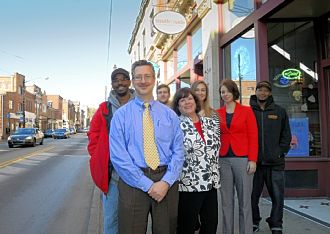
From left, Ron Goings, Rick Belloli, Aaron Sukenik, Judy Dyda, Rachael Glasder, Susie Puskar and DaVar Cutler of the South Side Local Development Co. -- Lake Fong/Post-Gazette
South Side Local Development Co., one of the most successful nonprofit real estate developers in Pittsburgh, will spend the next 18 months putting itself out of business.
The board decided to dissolve the little company whose 28-year tenure on the South Side has coincided with the neighborhood’s transformation in private property values, popularity and market economy.
A successor organization with a focus on public issues will be formed with community feedback to the South Side Planning Forum, the neighborhood’s umbrella for other groups, and the Pittsburgh Partnership for Neighborhood Development.
“This is an exciting transition, and I’m thinking of this as a huge success story,” said Ellen Kight, executive director of the Pittsburgh Partnership for Neighborhood Development. “They have really done what a (community development corporation) is supposed to do.”
Successful development corporations step in with public investment to help neighborhoods attract private investment. Some also have youth and job training programs, public safety committees and other outreach. The South Side nonprofit has largely focused on real estate and has built or renovated more than 100 homes in the past 20 years.
Private developers have added some 800.
“We’ve done our job,” said Tracy Myers, the company’s board president.
In 1982, when the company was founded, property values were two-thirds of the city’s median value, said executive director Rick Belloli. In 2008-09, those values were 170 percent of the city’s median. About 50 percent of the retail space along East Carson Street was vacant in 1982, and that rate is now at about 10 percent, he said.
Rob Stephany, executive director of the Urban Redevelopment Authority, said there is still work to be done by a high-capacity real estate nonprofit in the South Side’s adjacent neighborhoods.
“The target area is big, and the next step would be moving that [real estate] strength to the next frontier,” including Allentown and Arlington, he said.
“Clearly from a real estate value standpoint, the [development company] has been an invaluable piece of the puzzle,” he said. “The equity senior citizens have in their homes is growing, and that’s a proud moment. The fact that there are $400,000 sales in the South Side astounds me to this day.”
The remaining challenges largely have to do with the proliferation of bars, said Ms. Myers. “That’s a consequence of our success.”
The East Carson corridor’s accumulation of liquor licenses is considered to be at saturation by most stakeholders. Uncivil and drunken behavior on weekend nights has some homeowners at the breaking point. Resident Thomas Kolano said he is “very concerned a lot of people are actually talking about leaving the neighborhood.”
“If there isn’t a push-back from residents, this could become an undesirable place to live,” he said. “Sunday through Wednesday and some Thursdays it functions as a normal neighborhood — beautiful and vibrant. I love it. But Friday and Saturday are crazy. It’s like Jekyll and Hyde.”
The city has cracked down on parking violations in recent weeks, and Councilman Bruce Kraus has held several meetings to promote a management strategy for Carson businesses.
Mr. Stephany said a neighborhood improvement district “is an essential next step. The only way to correct some of the issues there is to have collaborative problem solving.”
A neighborhood improvement district is like a business improvement district, except it includes interests beyond those of businesses, such as parks. Participants pay a fee to have the interests of their stated district managed and maintained. The Pittsburgh Downtown Partnership is one example of a business improvement district.
A management strategy for East Carson businesses was recommended several years ago by consultants from the International Downtown Association. A committee of the South Side Planning Forum is gathering feedback to determine the range of focus of the successor organization.
The Pittsburgh Partnership for Neighborhood Development paid for an employee to go door-to-door to gather that feedback. The staff of the local development company will not be involved in the successor agency, although some of its board may be.
Ms. Myers said that while winding down, the agency “still has properties and buildings we want to make sure are well cared for. Some entity needs to keep an eye on these things, to protect all the progress we’ve made to improve the physical environment” and ensure that developers follow historic guidelines.
“Some things we do will have to be done by someone else or not get done,” she said. “The community has to set its priorities.”
-
Real Estate Workshop Celebrates City Living
Monday, November 01, 2010By Joe Smydo, Pittsburgh Post-GazetteUp hills, along tight curves and down into the river valleys, a bus full of local real-estate agents navigated Pittsburgh last week on a tour the Urban Redevelopment Authority put together to boost city home sales.
“I just got a whole different perspective,” said Mary Lynne Deets, education manager for the Realtors Association of Metropolitan Pittsburgh, who sold only about five homes in the city during a 30-year sales career.
That’s the kind of statistic the URA would like to change.
While open to all real estate professionals, the tour was designed to enlighten suburban agents unfamiliar with the city and all it has to offer. Officials hope their upbeat message will hit home, many times over.
“A lot of people want a walkable, pedestrian-friendly community to live in with a lot going on. That’s what urban living is all about,” said Kyra Straussman, URA real estate director.
Ms. Straussman said the URA ramped up home marketing efforts at Mayor Luke Ravenstahl’s direction about three years ago.
In May, the URA launched a Web site — Pittsburghcityliving.com — that pairs prospective home buyers with neighborhoods meeting their requirements. “It’s like Match.com for your neighborhood,” Ms. Straussman said.
The workshop for real estate agents, “City Living: A Focus on the Pittsburgh Client,” was another phase of the initiative. It was developed by Ms. Straussman; Josette Fitzgibbons, coordinator of the Mainstreets and Elm Street programs; and Megan Stearman, Mainstreets development specialist.
About 20 agents, most with little knowledge of the city, signed up. Under a special arrangement with the state Real Estate Commission, all received continuing education credits needed to maintain their licenses.
The agents saw new construction on the Central North Side, in Fineview and at Summerset at Frick Park. They heard about the house-by-house revival of Friendship, the development spurt in East Liberty and Lawrenceville’s recent emergence as a hot housing market.
They visited Riverview Park on the North Side, Pittsburgh Phillips K-5 on the South Side and Pittsburgh Brashear High School in Beechview. Sometimes, “neighborhood ambassadors” climbed aboard to talk about their communities and how civic groups augment the development work of city agencies.
“You know, we had rave reviews from the ‘students,’ ” Ms. Deets said, noting most continuing education workshops for real estate agents are classroom sessions on such issues as tax assessment and foreclosures.
Because the workshop was unusual, the Realtors Association had to persuade the Real Estate Commission to give the continuing education credits, Ms. Deets said. The participants did spend some time in a classroom, learning about tax abatement, other home buyer incentives and the Pittsburgh Public Schools.
To address concerns about the quality of city schools, the URA scheduled presentations about city magnet programs, the district’s academic improvement efforts and the Pittsburgh Promise college scholarship program. To counter other concerns about urban living, the URA arranged for the group to meet a man who’s raising two teenage girls on the South Side Flats and a single woman who lives in Allegheny West.
The URA plans to offer the workshop again in the spring. In the meantime, to track the success of last week’s program, the URA will send a thank-you gift to any participant who provides verification of a city home sale.
Ellen Connelly, a Howard Hanna agent who works mostly in the city, said the tour will make her job easier.
“I have an out-of-town client coming in. She’s looking at Sewickley. She’s looking at Fox Chapel. But she’s really focused on the city,” Ms. Connelly said.

